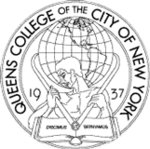Queens College, City University of New York
 |
|
| Motto | Discimus ut serviamus (Latin) |
|---|---|
|
Motto in English
|
"We Learn So That We May Serve" |
| Type | Public |
| Established | 1937 |
| President | Félix V. Matos Rodríguez |
|
Academic staff
|
1,693 |
| Students | 18,494 |
| Undergraduates | 14,384 |
| Postgraduates | 4,110 |
| Location |
New York City (Queens), New York, US 40°44′13″N 73°49′01″W / 40.737°N 73.817°WCoordinates: 40°44′13″N 73°49′01″W / 40.737°N 73.817°W |
| Campus | Urban, 77 acres (310,000 m2) |
| Newspaper | The Knight News |
| Colors | Blue and Silver |
| Athletics | NCAA Division II – ECC |
| Nickname | Knights |
| Mascot | Knight |
| Affiliations |
City University of New York AASCU |
| Website | www.qc.cuny.edu |
Queens College (QC) is one of the four-year colleges in the City University of New York system. Often referred to as “The College of the Future,” its 80-acre campus is located in a residential area of Flushing in the borough of Queens – America’s most ethnically diverse county – with a student body that represents over 170 countries. Queens College is consistently ranked among the leading institutions in the nation for the quality of its faculty and academic programs, the achievement of its students, and its affordability.
In 2013 Queens College was ranked #2 nationally by the Washington Monthly for giving students the "best bang for their bucks."
Before Queens College was established in 1937, the site of the campus was home to the Jamaica Academy, a one-room schoolhouse built in the early 19th century, where Walt Whitman once worked as teacher. The building was located on Flushing-Jamaica Road (later renamed Kissena Boulevard). Jamaica Academy became public in 1844. In 1909, the New York Parental School, a home for troubled boys, opened on the land surrounding the future site of Queens College and incorporated Jamaica Academy on its campus. Buildings such as Jefferson Hall (named after Thomas Jefferson) were used as both dormitories and classrooms.
In 1934, the New York Parental School was investigated amid rumors of abuse. The school was shut down and students were transferred to local public schools. A few months later, the grounds were turned over to the city. The city planned to house 500 mental patients from Randall's Island Hospital, who were temporarily displaced by the construction of the Triborough Bridge.
Meanwhile, County Judge Charles S. Colden appointed and chaired a committee to assess the feasibility of opening a free college in Queens. In September 1935, the committee recommended the establishment of such a college. Mayor La Guardia backed the recommendation and pushed for the free college's creation. In March 1937, the Board of Education designated the site of the former Parental School to be the future location of Queens College. Paul Klapper, former dean of the School of Education at City College of New York, was appointed the new college's president. The college opened in October 1937—later than anticipated due to a painters' strike—with 21 members on its teaching staff and 400 students in its inaugural freshmen class.
...
Wikipedia

